ANOVA Assignment: Hypothesis Testing and Statistical Analysis
VerifiedAdded on 2022/09/14
|8
|1106
|45
Homework Assignment
AI Summary
This assignment solution addresses various aspects of Analysis of Variance (ANOVA), a statistical method used to compare the means of two or more groups. The solution covers the main goal of ANOVA, which is to determine if there's a significant difference between the means of independent groups. It differentiates between t-tests and ANOVA, clarifies the role of the independent and dependent variables, and explains the hypothesis testing process within the ANOVA framework. The assignment also delves into the concepts of variance, the alternative hypothesis, and the different types of ANOVA designs, including independent and repeated measures. Furthermore, the solution addresses the definition of MANOVA and its distinction from ANOVA, along with the interpretation of F-values and the identification of critical regions. The assignment also includes examples and problem-solving scenarios related to ANOVA, providing a comprehensive understanding of the topic.
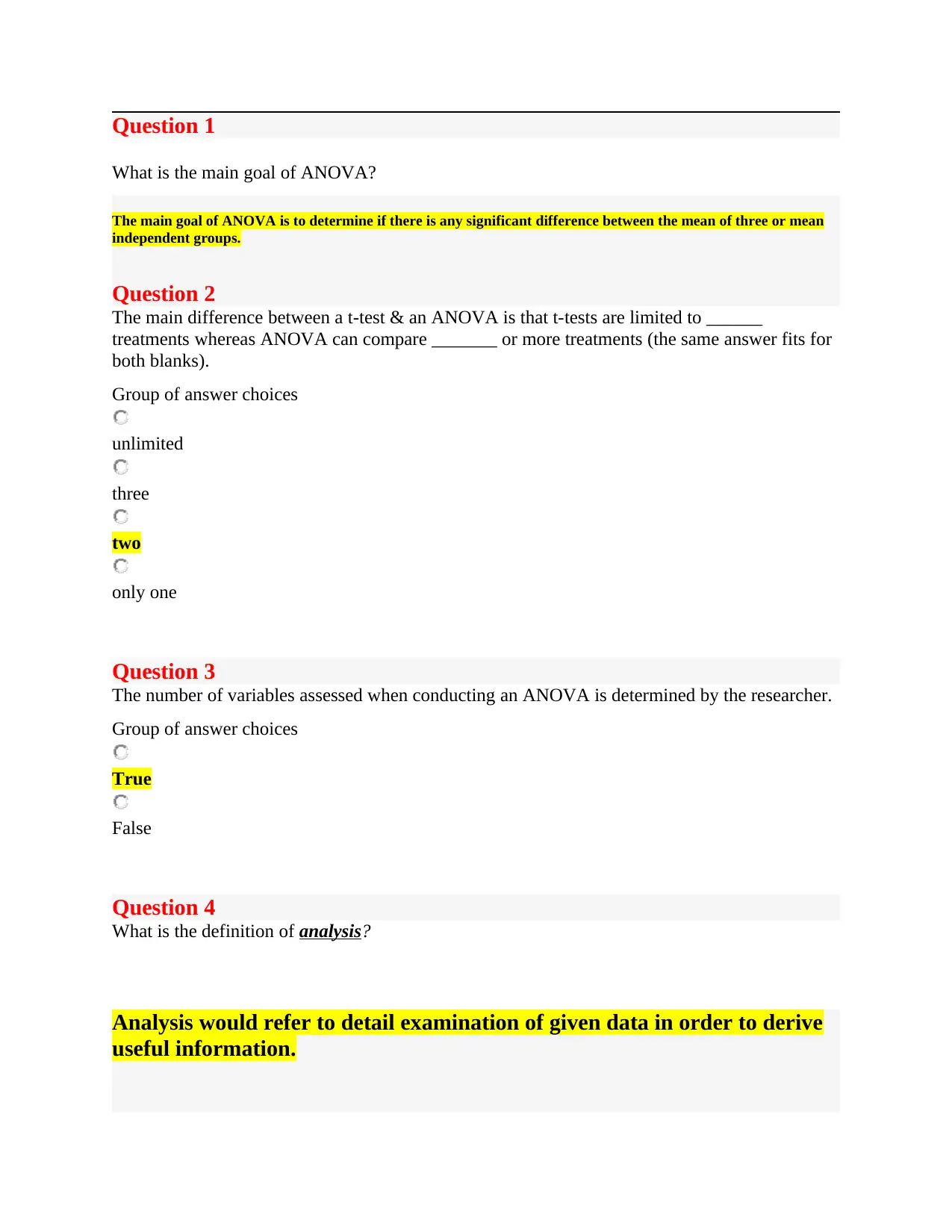
Question 1
What is the main goal of ANOVA?
The main goal of ANOVA is to determine if there is any significant difference between the mean of three or mean
independent groups.
Question 2
The main difference between a t-test & an ANOVA is that t-tests are limited to ______
treatments whereas ANOVA can compare _______ or more treatments (the same answer fits for
both blanks).
Group of answer choices
unlimited
three
two
only one
Question 3
The number of variables assessed when conducting an ANOVA is determined by the researcher.
Group of answer choices
True
False
Question 4
What is the definition of analysis?
Analysis would refer to detail examination of given data in order to derive
useful information.
What is the main goal of ANOVA?
The main goal of ANOVA is to determine if there is any significant difference between the mean of three or mean
independent groups.
Question 2
The main difference between a t-test & an ANOVA is that t-tests are limited to ______
treatments whereas ANOVA can compare _______ or more treatments (the same answer fits for
both blanks).
Group of answer choices
unlimited
three
two
only one
Question 3
The number of variables assessed when conducting an ANOVA is determined by the researcher.
Group of answer choices
True
False
Question 4
What is the definition of analysis?
Analysis would refer to detail examination of given data in order to derive
useful information.
Paraphrase This Document
Need a fresh take? Get an instant paraphrase of this document with our AI Paraphraser
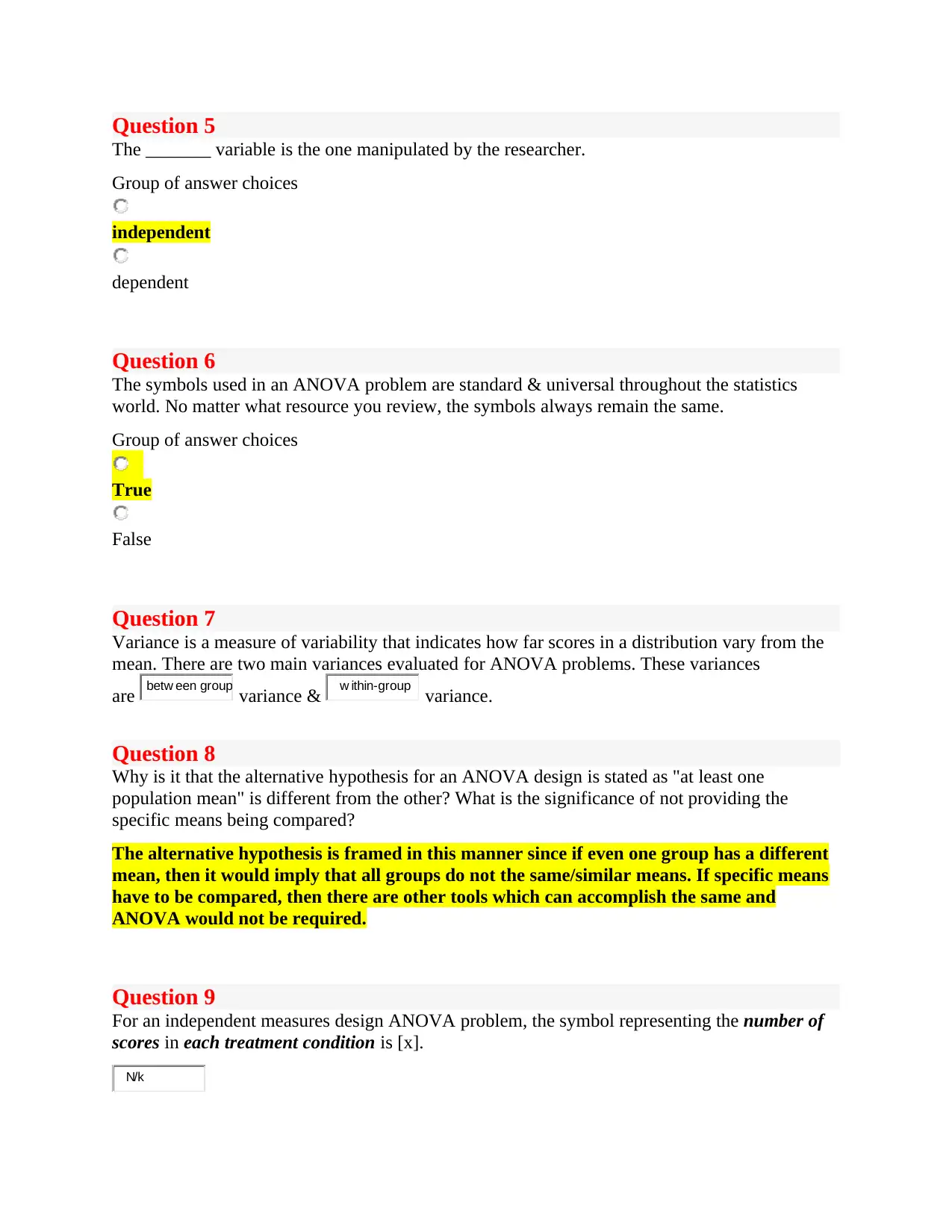
Question 5
The _______ variable is the one manipulated by the researcher.
Group of answer choices
independent
dependent
Question 6
The symbols used in an ANOVA problem are standard & universal throughout the statistics
world. No matter what resource you review, the symbols always remain the same.
Group of answer choices
True
False
Question 7
Variance is a measure of variability that indicates how far scores in a distribution vary from the
mean. There are two main variances evaluated for ANOVA problems. These variances
are variance & variance.
Question 8
Why is it that the alternative hypothesis for an ANOVA design is stated as "at least one
population mean" is different from the other? What is the significance of not providing the
specific means being compared?
The alternative hypothesis is framed in this manner since if even one group has a different
mean, then it would imply that all groups do not the same/similar means. If specific means
have to be compared, then there are other tools which can accomplish the same and
ANOVA would not be required.
Question 9
For an independent measures design ANOVA problem, the symbol representing the number of
scores in each treatment condition is [x].
betw een group w ithin-group
N/k
The _______ variable is the one manipulated by the researcher.
Group of answer choices
independent
dependent
Question 6
The symbols used in an ANOVA problem are standard & universal throughout the statistics
world. No matter what resource you review, the symbols always remain the same.
Group of answer choices
True
False
Question 7
Variance is a measure of variability that indicates how far scores in a distribution vary from the
mean. There are two main variances evaluated for ANOVA problems. These variances
are variance & variance.
Question 8
Why is it that the alternative hypothesis for an ANOVA design is stated as "at least one
population mean" is different from the other? What is the significance of not providing the
specific means being compared?
The alternative hypothesis is framed in this manner since if even one group has a different
mean, then it would imply that all groups do not the same/similar means. If specific means
have to be compared, then there are other tools which can accomplish the same and
ANOVA would not be required.
Question 9
For an independent measures design ANOVA problem, the symbol representing the number of
scores in each treatment condition is [x].
betw een group w ithin-group
N/k
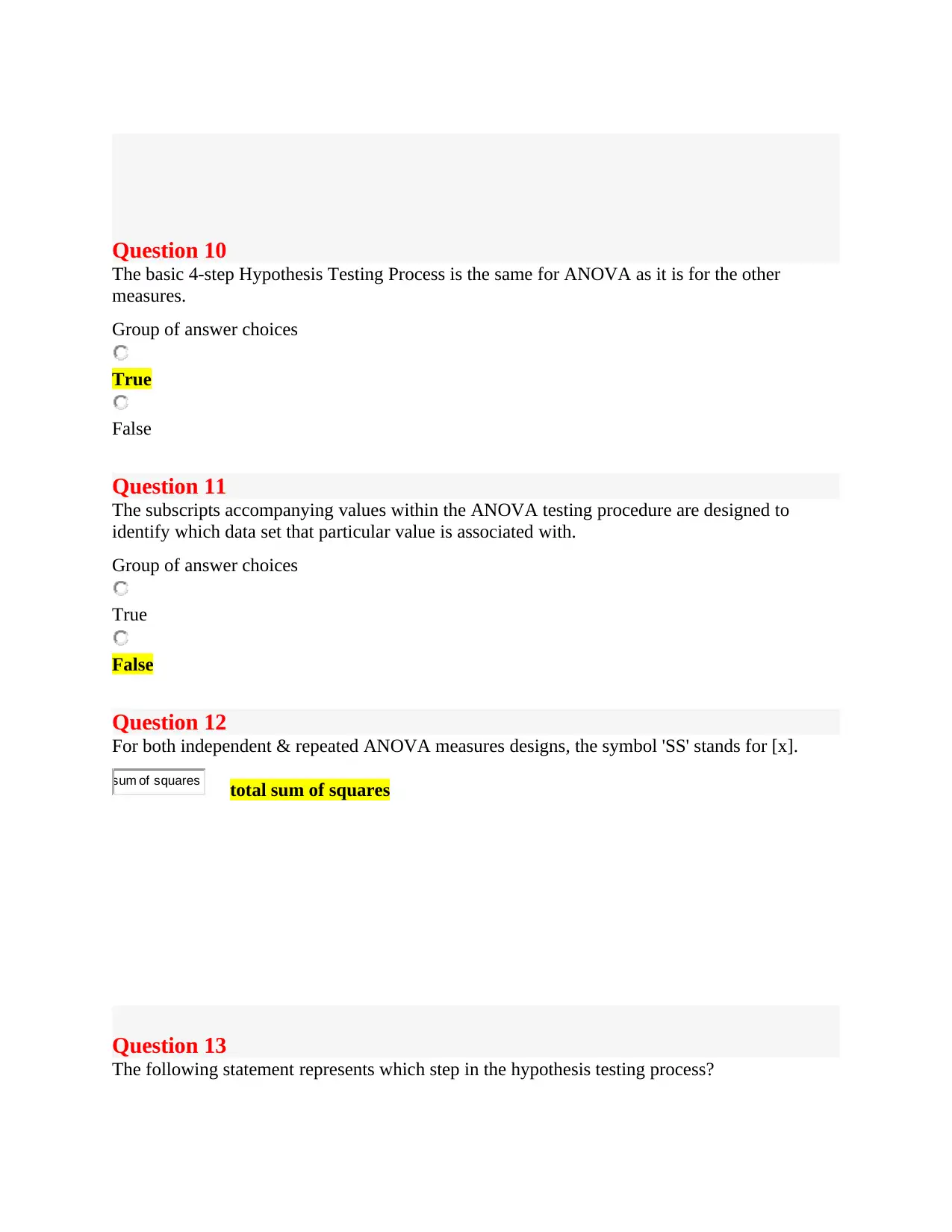
Question 10
The basic 4-step Hypothesis Testing Process is the same for ANOVA as it is for the other
measures.
Group of answer choices
True
False
Question 11
The subscripts accompanying values within the ANOVA testing procedure are designed to
identify which data set that particular value is associated with.
Group of answer choices
True
False
Question 12
For both independent & repeated ANOVA measures designs, the symbol 'SS' stands for [x].
total sum of squares
Question 13
The following statement represents which step in the hypothesis testing process?
total sum of squares
The basic 4-step Hypothesis Testing Process is the same for ANOVA as it is for the other
measures.
Group of answer choices
True
False
Question 11
The subscripts accompanying values within the ANOVA testing procedure are designed to
identify which data set that particular value is associated with.
Group of answer choices
True
False
Question 12
For both independent & repeated ANOVA measures designs, the symbol 'SS' stands for [x].
total sum of squares
Question 13
The following statement represents which step in the hypothesis testing process?
total sum of squares
⊘ This is a preview!⊘
Do you want full access?
Subscribe today to unlock all pages.

Trusted by 1+ million students worldwide
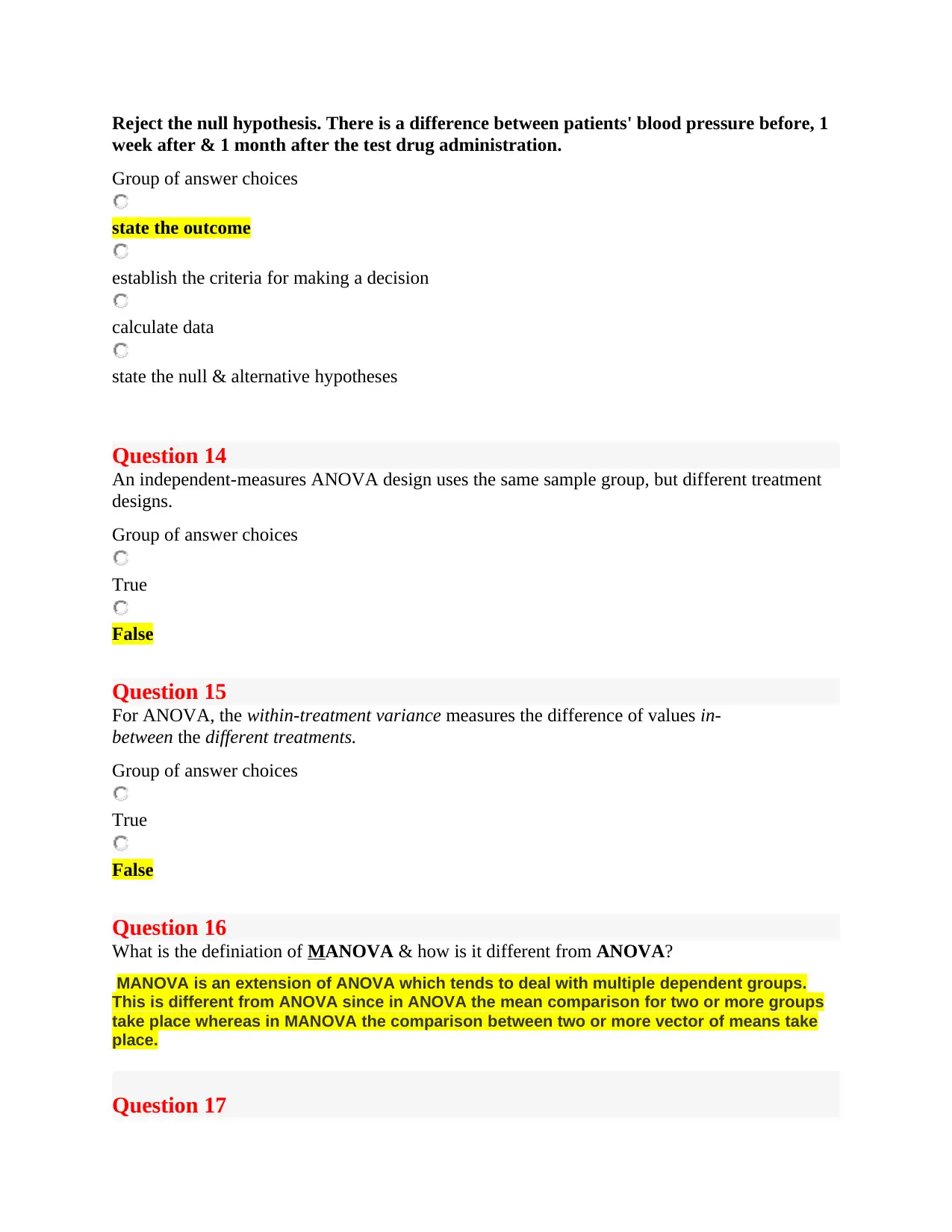
Reject the null hypothesis. There is a difference between patients' blood pressure before, 1
week after & 1 month after the test drug administration.
Group of answer choices
state the outcome
establish the criteria for making a decision
calculate data
state the null & alternative hypotheses
Question 14
An independent-measures ANOVA design uses the same sample group, but different treatment
designs.
Group of answer choices
True
False
Question 15
For ANOVA, the within-treatment variance measures the difference of values in-
between the different treatments.
Group of answer choices
True
False
Question 16
What is the definiation of MANOVA & how is it different from ANOVA?
MANOVA is an extension of ANOVA which tends to deal with multiple dependent groups.
This is different from ANOVA since in ANOVA the mean comparison for two or more groups
take place whereas in MANOVA the comparison between two or more vector of means take
place.
Question 17
week after & 1 month after the test drug administration.
Group of answer choices
state the outcome
establish the criteria for making a decision
calculate data
state the null & alternative hypotheses
Question 14
An independent-measures ANOVA design uses the same sample group, but different treatment
designs.
Group of answer choices
True
False
Question 15
For ANOVA, the within-treatment variance measures the difference of values in-
between the different treatments.
Group of answer choices
True
False
Question 16
What is the definiation of MANOVA & how is it different from ANOVA?
MANOVA is an extension of ANOVA which tends to deal with multiple dependent groups.
This is different from ANOVA since in ANOVA the mean comparison for two or more groups
take place whereas in MANOVA the comparison between two or more vector of means take
place.
Question 17
Paraphrase This Document
Need a fresh take? Get an instant paraphrase of this document with our AI Paraphraser
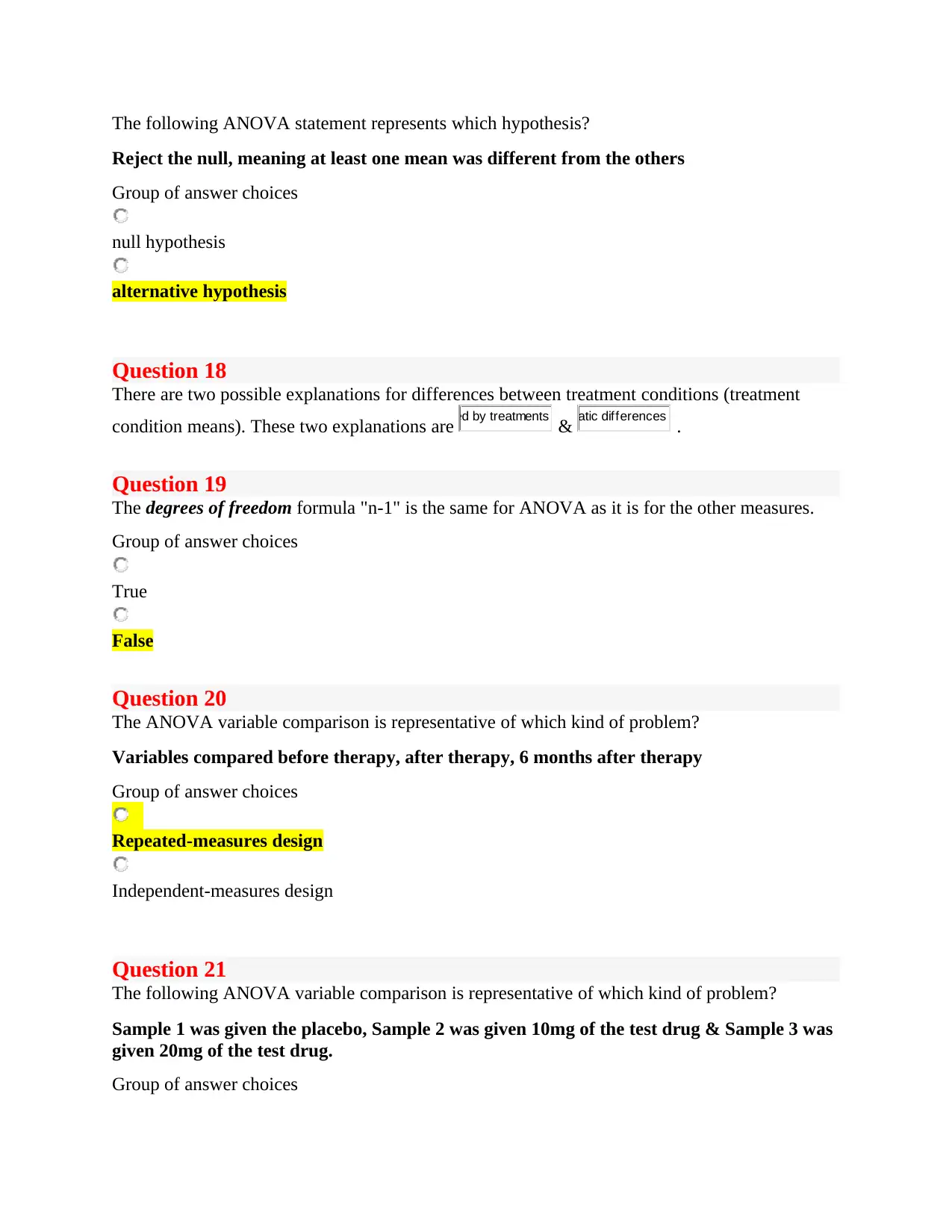
The following ANOVA statement represents which hypothesis?
Reject the null, meaning at least one mean was different from the others
Group of answer choices
null hypothesis
alternative hypothesis
Question 18
There are two possible explanations for differences between treatment conditions (treatment
condition means). These two explanations are & .
Question 19
The degrees of freedom formula "n-1" is the same for ANOVA as it is for the other measures.
Group of answer choices
True
False
Question 20
The ANOVA variable comparison is representative of which kind of problem?
Variables compared before therapy, after therapy, 6 months after therapy
Group of answer choices
Repeated-measures design
Independent-measures design
Question 21
The following ANOVA variable comparison is representative of which kind of problem?
Sample 1 was given the placebo, Sample 2 was given 10mg of the test drug & Sample 3 was
given 20mg of the test drug.
Group of answer choices
systematic differences caused by treatmentsrandom unsystematic differences
Reject the null, meaning at least one mean was different from the others
Group of answer choices
null hypothesis
alternative hypothesis
Question 18
There are two possible explanations for differences between treatment conditions (treatment
condition means). These two explanations are & .
Question 19
The degrees of freedom formula "n-1" is the same for ANOVA as it is for the other measures.
Group of answer choices
True
False
Question 20
The ANOVA variable comparison is representative of which kind of problem?
Variables compared before therapy, after therapy, 6 months after therapy
Group of answer choices
Repeated-measures design
Independent-measures design
Question 21
The following ANOVA variable comparison is representative of which kind of problem?
Sample 1 was given the placebo, Sample 2 was given 10mg of the test drug & Sample 3 was
given 20mg of the test drug.
Group of answer choices
systematic differences caused by treatmentsrandom unsystematic differences
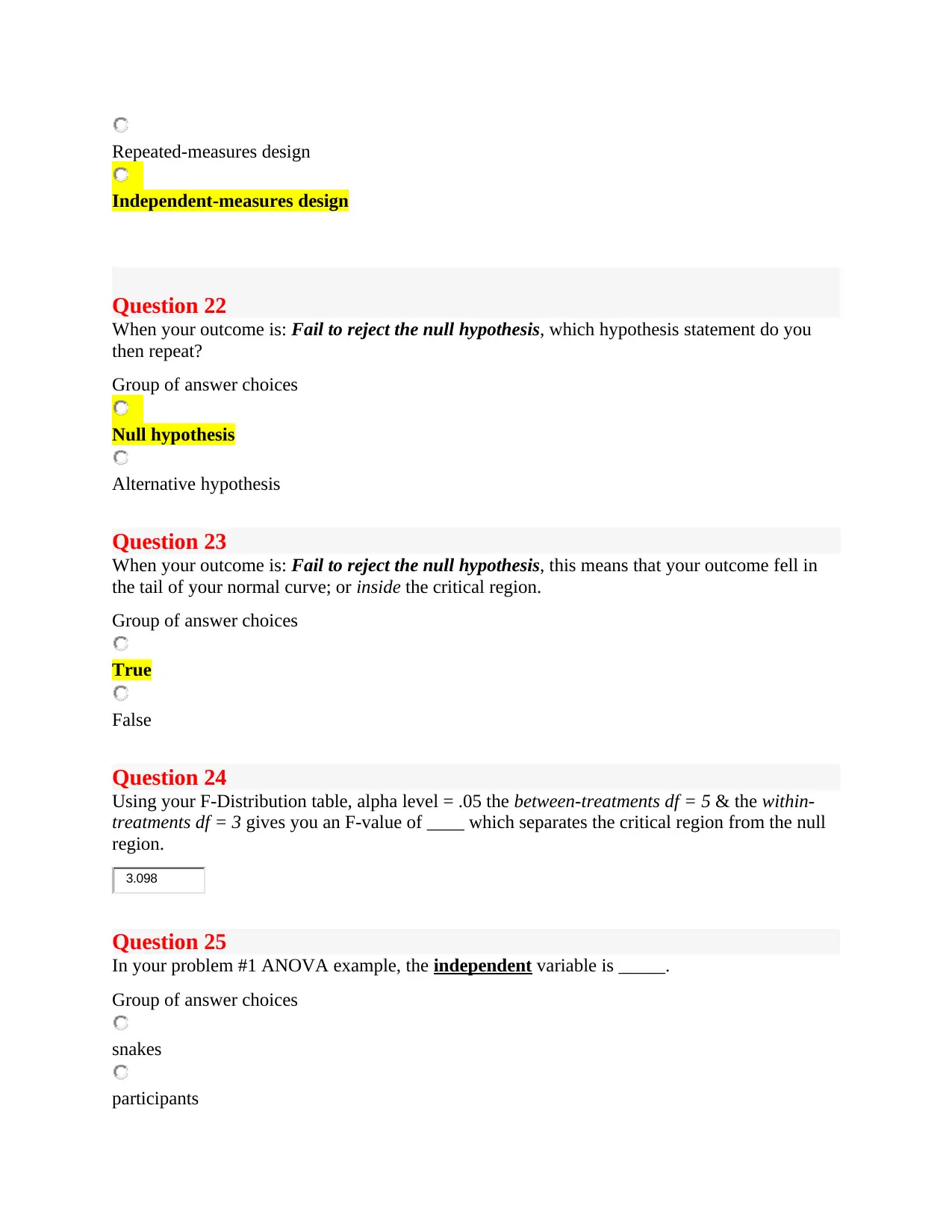
Repeated-measures design
Independent-measures design
Question 22
When your outcome is: Fail to reject the null hypothesis, which hypothesis statement do you
then repeat?
Group of answer choices
Null hypothesis
Alternative hypothesis
Question 23
When your outcome is: Fail to reject the null hypothesis, this means that your outcome fell in
the tail of your normal curve; or inside the critical region.
Group of answer choices
True
False
Question 24
Using your F-Distribution table, alpha level = .05 the between-treatments df = 5 & the within-
treatments df = 3 gives you an F-value of ____ which separates the critical region from the null
region.
Question 25
In your problem #1 ANOVA example, the independent variable is _____.
Group of answer choices
snakes
participants
3.098
Independent-measures design
Question 22
When your outcome is: Fail to reject the null hypothesis, which hypothesis statement do you
then repeat?
Group of answer choices
Null hypothesis
Alternative hypothesis
Question 23
When your outcome is: Fail to reject the null hypothesis, this means that your outcome fell in
the tail of your normal curve; or inside the critical region.
Group of answer choices
True
False
Question 24
Using your F-Distribution table, alpha level = .05 the between-treatments df = 5 & the within-
treatments df = 3 gives you an F-value of ____ which separates the critical region from the null
region.
Question 25
In your problem #1 ANOVA example, the independent variable is _____.
Group of answer choices
snakes
participants
3.098
⊘ This is a preview!⊘
Do you want full access?
Subscribe today to unlock all pages.

Trusted by 1+ million students worldwide
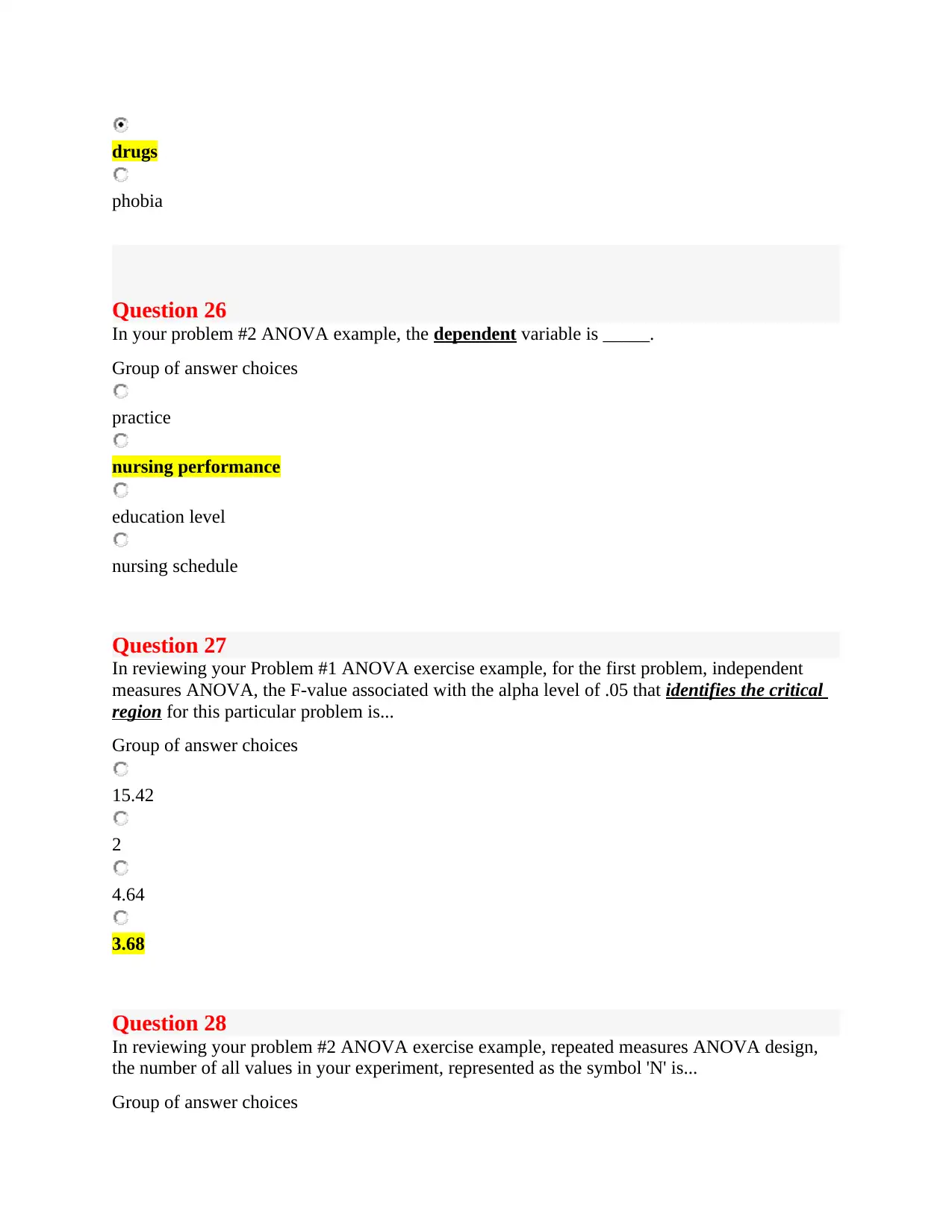
drugs
phobia
Question 26
In your problem #2 ANOVA example, the dependent variable is _____.
Group of answer choices
practice
nursing performance
education level
nursing schedule
Question 27
In reviewing your Problem #1 ANOVA exercise example, for the first problem, independent
measures ANOVA, the F-value associated with the alpha level of .05 that identifies the critical
region for this particular problem is...
Group of answer choices
15.42
2
4.64
3.68
Question 28
In reviewing your problem #2 ANOVA exercise example, repeated measures ANOVA design,
the number of all values in your experiment, represented as the symbol 'N' is...
Group of answer choices
phobia
Question 26
In your problem #2 ANOVA example, the dependent variable is _____.
Group of answer choices
practice
nursing performance
education level
nursing schedule
Question 27
In reviewing your Problem #1 ANOVA exercise example, for the first problem, independent
measures ANOVA, the F-value associated with the alpha level of .05 that identifies the critical
region for this particular problem is...
Group of answer choices
15.42
2
4.64
3.68
Question 28
In reviewing your problem #2 ANOVA exercise example, repeated measures ANOVA design,
the number of all values in your experiment, represented as the symbol 'N' is...
Group of answer choices
Paraphrase This Document
Need a fresh take? Get an instant paraphrase of this document with our AI Paraphraser
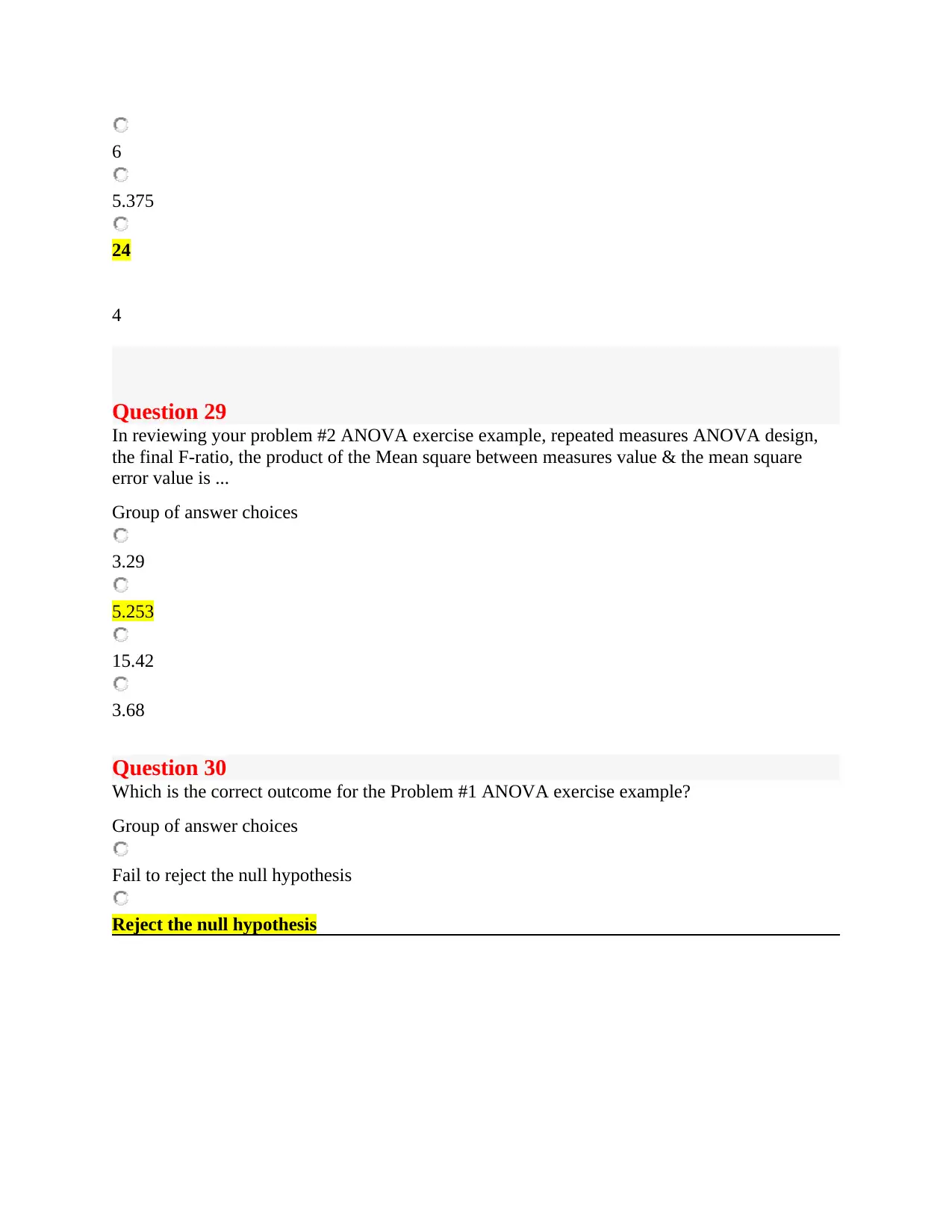
6
5.375
24
4
Question 29
In reviewing your problem #2 ANOVA exercise example, repeated measures ANOVA design,
the final F-ratio, the product of the Mean square between measures value & the mean square
error value is ...
Group of answer choices
3.29
5.253
15.42
3.68
Question 30
Which is the correct outcome for the Problem #1 ANOVA exercise example?
Group of answer choices
Fail to reject the null hypothesis
Reject the null hypothesis
5.375
24
4
Question 29
In reviewing your problem #2 ANOVA exercise example, repeated measures ANOVA design,
the final F-ratio, the product of the Mean square between measures value & the mean square
error value is ...
Group of answer choices
3.29
5.253
15.42
3.68
Question 30
Which is the correct outcome for the Problem #1 ANOVA exercise example?
Group of answer choices
Fail to reject the null hypothesis
Reject the null hypothesis
1 out of 8
Related Documents
Your All-in-One AI-Powered Toolkit for Academic Success.
+13062052269
info@desklib.com
Available 24*7 on WhatsApp / Email
![[object Object]](/_next/static/media/star-bottom.7253800d.svg)
Unlock your academic potential
Copyright © 2020–2025 A2Z Services. All Rights Reserved. Developed and managed by ZUCOL.





